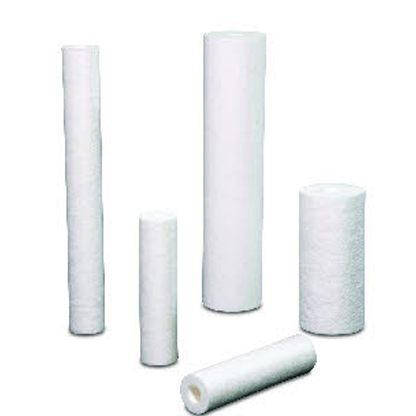
1. Switch off any pumps feeding the filter and isolate the power supply
2. Depressurise the system, for example by opening a tap being fed from the filter.
3. Turn off the water supply to the filter. If the filter is a Valve-in-Head model, rotate the handle on the top of the housing to the OFF position.
4. Depress the pressure release button (if present) to relieve the pressure in the filter bowl.
5. Unscrew the filter bowl using the spanner wrench which was provided for this filter.
NOTE: When opening the filter housing to change the cartridge, the O-ring/gasket may lift out of the housing. Do not lose the O-ring/gasket.
6. Remove the used cartridge and discard safely.
7. Inspect the filter bowl and wash thoroughly using detergent and a soft brush or sponge, rinse thoroughly with clean water and dry with a clean and sterile paper towel.
8. Inspect the underside of the filter head and wash thoroughly with detergent, rinse thoroughly and dry with a clean and sterile paper towel.
9. Remove the O-ring/gasket from the filter, wash thoroughly with detergent, rinse thoroughly and dry with a clean and sterile paper towel.
10. Lubricate the O-ring/gasket with a coating of clean silicone grease. Place the O-ring/gasket back in place and press into place with two fingers.
NOTE: This step is important to ensure a proper filter seal.
CAUTION: If the O-ring/gasket appears to be damaged or crimped it should be discarded and replaced. Replacement parts can be obtained from Filpumps.
11. Insert a new cartridge into the filter bowl making sure that it slips down over the locating spigot.
12. Insert one sterilant tablet into the filter bowl on the outside of the cartridge. This will sterilise the system and will dissolve in one to two days under normal water use.
13. Screw the filter bowl into the filter head and hand tighten. DO NOT OVER-TIGHTEN. Make sure that the cartridge slips over the spigot in the filter head.
14. Turn on the water supply slowly to allow the housing to fill with water. When using a Valve-in-Head, rotate the handle slowly to the ON (filter) position.
15. Depress the pressure release button (if present) to release any trapped air from the filter.
16. Check for leaks before leaving the installation.
WARNING: Do not use with water that is microbiologically unsafe or of unknown quality without adequate disinfection or treatment before or after the unit.
Each time you use water from your filtered water tap for drinking or cooking purposes, it is recommended that you run (flush) the tap at least 10 seconds prior to using water. This is particularly important if the water tap is not used daily.
CAUTION: Filter must be protected against freezing. Failure to do so may result in cracking of the filter and water leakage.
CAUTION: All filtration systems contain other parts that have a limited service life. Exhaustion of the service life of those parts often cannot be easily detected. Commonly, it is only after leakage has been observed or water damage has occurred that one is made aware that the service life has been exhausted
NOTE: Certain types of harmless bacteria will attack cellulose material. Cartridges containing cellulose may seem to disintegrate, produce a “musty” or “mouldy” odour, or form a black precipitate due to the bacteria. If you notice any of the above problems while using the cellulose media cartridges, switch to a synthetic media cartridge or consult Filpumps Sales Dept.
NOTE: This replacement cartridge has a limited service life and should be changed at least every 3 months. Changes in taste, colour and flow of the water being filtered are signals that replacement of the cartridge is or soon may be necessary.
IMPORTANT NOTICE: To prevent costly repairs or possible water damage we strongly recommend that the filter bowl of all plastic housings be replaced periodically: every five years for filter bowls and every ten years for opaque filter bowls. If your filter bowl has been in use for more than the recommended period, it should be replaced immediately. Be sure to date any new or replacement filter bowl for future reference and indicate the next recommended replacement date.